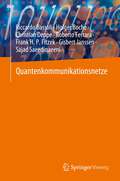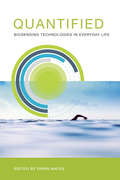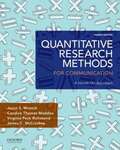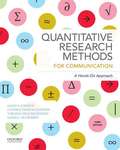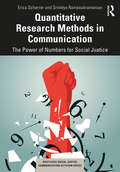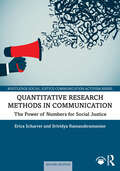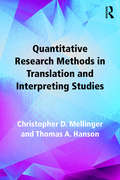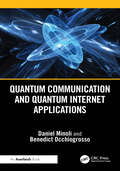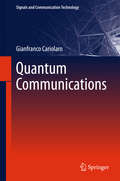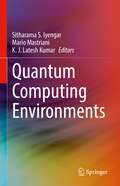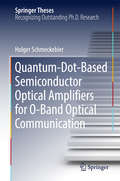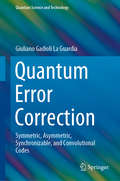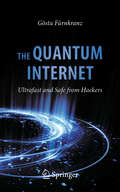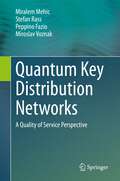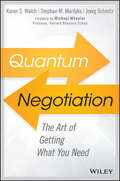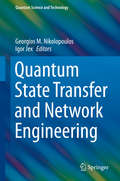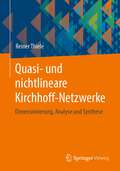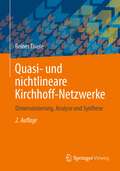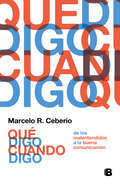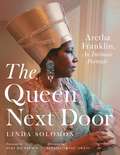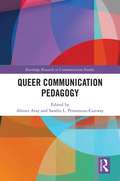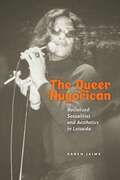- Table View
- List View
Quantenkommunikationsnetze
by Riccardo Bassoli Holger Boche Christian Deppe Roberto Ferrara Frank H. Fitzek Gisbert Janssen Sajad SaeedinaeeniDieses Buch bietet ein Tutorial über Quantenkommunikationsnetze. Die Autoren erörtern aktuelle Paradigmenwechsel in Kommunikationsnetzen, die erforderlich sind, um die einfachen Transportkonzepte der vorherrschenden Netze um Rechen- und Speicherfunktionen zu ergänzen. Sie zeigen, wie diese "softwarisierten" Lösungen neue Wege beschreiten, um Latenzzeiten zu reduzieren und die Ausfallsicherheit zu erhöhen. Die Autoren erörtern, wie diese Lösungen trotz der ihnen innewohnenden Probleme aufgrund der eingeführten Rechenlatenz und des Energieverbrauchs durch hybride klassisch-quantische Kommunikationsnetze gelöst werden können. Das Buch bringt Quantennetzwerke, Quanteninformationstheorie, Quantencomputer und Quantensimulation zusammen.
Quantified: Biosensing Technologies in Everyday Life
by Dawn NafusWhat is at stake socially, culturally, politically, and economically when we routinely use technology to gather information about our bodies and environments? Today anyone can purchase technology that can track, quantify, and measure the body and its environment. Wearable or portable sensors detect heart rates, glucose levels, steps taken, water quality, genomes, and microbiomes, and turn them into electronic data. Is this phenomenon empowering, or a new form of social control? Who volunteers to enumerate bodily experiences, and who is forced to do so? Who interprets the resulting data? How does all this affect the relationship between medical practice and self care, between scientific and lay knowledge? Quantified examines these and other issues that arise when biosensing technologies become part of everyday life.The book offers a range of perspectives, with views from the social sciences, cultural studies, journalism, industry, and the nonprofit world. The contributors consider data, personhood, and the urge to self-quantify; legal, commercial, and medical issues, including privacy, the outsourcing of medical advice, and self-tracking as a “paraclinical” practice; and technical concerns, including interoperability, sociotechnical calibration, alternative views of data, and new space for design.ContributorsMarc Böhlen, Geoffrey C. Bowker, Sophie Day, Anna de Paula Hanika, Deborah Estrin, Brittany Fiore-Gartland, Dana Greenfield, Judith Gregory, Mette Kragh-Furbo, Celia Lury, Adrian Mackenzie, Rajiv Mehta, Maggie Mort, Dawn Nafus, Gina Neff, Helen Nissenbaum, Heather Patterson, Celia Roberts, Jamie Sherman, Alex Taylor, Gary Wolf
Quantitative Research Methods For Communication: A Hands-on Approach
by Jason S. Wrench Candice Thomas-Maddox Virginia Peck RichmondQuantitative Research Methods for Communication: A Hands-On Approach is a relevant and accessible guide to quantitative research. In clear, straightforward language, the authors encourage students to take an active, hands-on role in the learning process, giving them the tools they need to locate, conduct, collect and present their research. The authors use real communication studies and data sets to make communication research come alive for students. Students are not only introduced to new skills but also given the opportunity to immediately apply these skills in research scenarios. The text integrates helpful features throughout, including chapter objectives, case studies, data sheets, and key terms.
Quantitative Research Methods for Communication: A Hands-On Approach
by Jason S. Wrench Candice Thomas-Maddox Virginia Peck Richmond James C. McCroskeyThis book is a comprehensive and engaging guide to quantitative research. Drawing on their extensive research and teaching experience, the authors encourage students to take an active, hands-on role in the learning process. After giving students the tools they need to locate, conduct, collect, and present their research, the text provides them with the opportunity to immediately apply these skills in research scenarios.
Quantitative Research Methods in Communication: The Power of Numbers for Social Justice (Routledge Social Justice Communication Activism Series)
by Erica Scharrer Srividya RamasubramanianThis textbook is an advanced introduction to quantitative methods for students in communication and allied social science disciplines that focuses on why and how to conduct research that contributes to social justice. Today’s researchers are inspired by the potential for scholarship to make a difference for society, to push toward more just and equitable ends, and to engage in dialogue with members of the public so that they can make decisions about how to navigate the social, cultural, and political world equipped with accurate, fair, and up-to-date knowledge. This book illustrates the mechanics and the meaning behind quantitative research methods by illustrating each step in the research design process with research addressing questions of social justice. It provides practical guidance for researchers who wish to engage in the transformation of structures, practices, and understandings in society through community and civic engagement and policy formation. It contains step-by-step guidance in quantitative methods—from conceptualization through all the stages of execution of a study, including providing a detailed guide for statistical analysis—and demonstrates how researchers can engage with social justice issues in systematic, rigorous, ethical, and meaningful ways. This text serves as a core or supplementary textbook for graduate and advanced undergraduate courses in research methods for communication and social sciences and fills a gap for a methods text that is responsive to the desire of scholars to conduct socially impactful research.
Quantitative Research Methods in Communication: The Power of Numbers for Social Justice (Routledge Social Justice Communication Activism Series)
by Erica Scharrer Srividya RamasubramanianThis fully updated second edition offers an advanced introduction to quantitative methods that focuses on why and how to conduct research that contributes to social justice.Providing both inspiration and step-by-step guidance on how to conceive, design, and carry out a quantitative study, the book shows how research can be used to work toward a more just and equitable world. The authors provide a detailed guide to quantitative methods and statistical analysis, showing how researchers can engage with social justice issues in systematic, rigorous, ethical, and meaningful ways. This new edition includes a new chapter on writing literature reviews and better aligns with the stages of quantitative research as well as the changing technologies that are available for researchers to both study and use in their work. It includes updated real-world case studies, interviews with scholar-activists, and definitions of key concepts as well as a deeper focus on ethics, social media, computational social sciences, data analytics, and data visualization techniques.Attuned to questions of access, equity, justice, diversity, and inclusion, this textbook is ideal for graduate and advanced undergraduate courses in research methods for communication and the social sciences. It will also be of interest to researchers who wish to engage with the transformation of structures, practices, and understandings in society through community and civic engagement and policy formation.Online resources for instructors include a test bank, PowerPoint slides, sample dataset, and YouTube tutorials. They are available online at www.routledge.com/9781032599878.
Quantitative Research Methods in Translation and Interpreting Studies
by Christopher Mellinger Thomas A. HansonQuantitative Research Methods in Translation and Interpreting Studies encompasses all stages of the research process that include quantitative research methods, from conceptualization to reporting. In five parts, the authors cover: • sampling techniques, measurement, and survey design; • how to describe data; • how to analyze differences; • how to analyze relationships; • how to interpret results. Each part includes references to additional resources and extensive examples from published empirical work. A quick reference table for specific tests is also included in the appendix. This user-friendly guide is the essential primer on quantitative methods for all students and researchers in translation and interpreting studies. Accompanying materials are available online, including step-by-step walkthroughs of how analysis was conducted, and extra sample data sets for instruction and self study: https://www.routledge.com/9781138124967. Further resources for Translation and Interpreting Studies are available on the Routledge Translation Studies Portal: http://cw.routledge.com/textbooks/translationstudies.
Quantum Communication and Quantum Internet Applications
by Daniel Minoli Benedict OcchiogrossoQuantum computing, particularly in conjunction with a high level of interconnectivity facilitated by quantum connectivity, can facilitate a host of new, previously unattainable applications—these include blind quantum computation, (information) teleporting, clock synchronization, quantum key distribution, secure access to remote quantum computers, superdense coding, secure identification, quantum-secure encryption, distributed sensors, and other scientific and commercial applications, including new drug development.Quantum Communication and Quantum Internet Applications is a basic introduction to quantum computing and presents the emerging foundations of quantum communications and applications. Written for telecommunications professionals, the book explains basic principles of quantum mechanics and strives to make quantum science accessible with a minimal mathematical investment. This book is a point of departure into the application of quantum computing and mechanics to communications. Features include: An introductory overview of quantum communications Basic and advanced mathematical concepts in quantum physics Basic physical technologies An overview of quantum computers and their role as nodes in the quantum internet (i.e., the Quaint) Quantum communications, including logical architectures and the Quaint Quantum-based security Software tools to develop networked quantum applications. Glossaries of terms and concepts. The book synthetizes background material on quantum computing so that telecom managers and other telecom professionals can get a basic understanding of this fast-emerging computing discipline and its application to telecom. It is a guide to the newly emerging fields of quantum communications, quantum internet, remote connectivity, and networking.
Quantum Communication Networks (Foundations in Signal Processing, Communications and Networking #23)
by Frank H. Fitzek Holger Boche Christian Deppe Riccardo Bassoli Roberto Ferrara Gisbert Janssen Sajad SaeedinaeeniThis book provides a tutorial on quantum communication networks. The authors discuss current paradigm shifts in communication networks that are needed to add computing and storage to the simple transport ideas of prevailing networks. They show how these ‘softwarized’ solutions break new grounds to reduce latency and increase resilience. The authors discuss how even though these solutions have inherent problems due to introduced computing latency and energy consumption, the problems can be solved by hybrid classical-quantum communication networks. The book brings together quantum networking, quantum information theory, quantum computing, and quantum simulation.
Quantum Communications
by Gianfranco CariolaroThis book demonstrates that a quantum communication system using the coherent light of a laser can achieve performance orders of magnitude superior to classical optical communications Quantum Communications provides the Masters and PhD signals or communications student with a complete basics-to-applications course in using the principles of quantum mechanics to provide cutting-edge telecommunications. Assuming only knowledge of elementary probability, complex analysis and optics, the book guides its reader through the fundamentals of vector and Hilbert spaces and the necessary quantum-mechanical ideas, simply formulated in four postulates. A turn to practical matters begins with and is then developed by: · development of the concept of quantum decision, emphasizing the optimization of measurements to extract useful information from a quantum system; · general formulation of a transmitter-receiver system · particular treatment of the most popular quantum communications systems--OOK, PPM, PSK and QAM; · more realistic performance evaluation introducing thermal noise and system description with density operators; · consideration of scarce existing implementations of quantum communications systems and their difficulties with suggestions for future improvement; and · separate treatment of quantum information with discrete and continuous states. Quantum Communications develops the engineering student's exposure to quantum mechanics and shows physics students that its theories can have practically beneficial application in communications systems. The use of example and exercise questions (together with a downloadable solutions manual for instructors) will help to make the material presented really sink in for students and invigorate subsequent research.
Quantum Computing Environments
by Sitharama S. Iyengar Mario Mastriani K. J. Latesh KumarThis book explains the evolution of techniques and strategies in quantum computing, discussing the digital transition towards the quantum computing application in various sectors. The book provides a comprehensive insight into the quantum mechanics and quantum computing techniques and tools and how they have evolved and the impacted in supporting and flourishing business during the quantum computing era. This book includes chapters that discuss the most primitive quantum schemes to the most recent use of Internet, finance and radar technology, thus leveraging greater use of new technologies like security and Internet and others. The content is relevant for an audience that is involved in the research and development of advanced quantum systems. It gives the industry, researchers, and students interested in learning the various quantum computing sectors with the necessary information and tools that can be used to research, design and develop advanced quantum computing systems and techniques.
Quantum Computing Strategy: Foundations and Applicability
by Elena YndurainQuantum computing is not merely an incremental advancement in computing technology; it represents a fundamentally new paradigm, distinct from classical computing. Rooted in quantum mechanics, it introduces an entirely novel information theory. As a result, translating existing models, solution designs, and approaches to quantum computing is a complex, non-trivial task. This comprehensive book demystifies quantum concepts through accessible explanations, practical case studies, and real-world examples from industries such as aerospace, agriculture, automotive, chemicals, energy, finance, government, healthcare, manufacturing, supply chain, and telecommunications.Blending a business perspective with a scientific rigor, this book is divided into two parts. The first part covers foundational technical concepts, including quantum mechanics principles that enable quantum technologies, key quantum algorithms, mathematical frameworks, quantum computing technologies, post-quantum cryptography, the types of problems quantum computers solve, and the technology’s outlook. The second part focuses on practical applicability, presenting industry use cases, guidance on approaching quantum computing problems, mapping use cases to quantum computing, responsible quantum computing practices, and a roadmap for businesses preparing for quantum adoption. This structured approach equips readers with the knowledge and tools to effectively integrate quantum computing into their strategic planning.Quantum Computing Strategy: Foundations and Applicability serves as an essential reference for technology enthusiasts, business leaders, policymakers, and educators seeking to understand the benefits quantum computing offers enterprises. Designed as a self-contained learning resource, it empowers readers to navigate the emerging quantum landscape confidently.
Quantum-Dot-Based Semiconductor Optical Amplifiers for O-Band Optical Communication
by Holger SchmeckebierThis thesis examines the unique properties of gallium arsenide (GaAs)-based quantum-dot semiconductor optical amplifiers for optical communication networks, introducing readers to their fundamentals, basic parameters and manifold applications. The static and dynamic properties of these amplifiers are discussed extensively in comparison to conventional, non quantum-dot based amplifiers, and their unique advantages are elaborated on, such as the fast carrier dynamics and the decoupling of gain and phase dynamics. In addition to diverse amplification scenarios involving single and multiple high symbol rate amplitude and phase-coded data signals, wide-range wavelength conversion as a key functionality for optical signal processing is investigated and discussed in detail. Furthermore, two novel device concepts are developed and demonstrated that have the potential to significantly simplify network architectures, reducing the investment and maintenance costs as well as the energy consumption of future networks.
Quantum Error Correction: Symmetric, Asymmetric, Synchronizable, and Convolutional Codes (Quantum Science and Technology)
by Giuliano Gadioli La GuardiaThis text presents an algebraic approach to the construction of several important families of quantum codes derived from classical codes by applying the well-known Calderbank-Shor-Steane (CSS), Hermitian, and Steane enlargement constructions to certain classes of classical codes. In addition, the book presents families of asymmetric quantum codes with good parameters and provides a detailed description of the procedures adopted to construct families of asymmetric quantum convolutional codes.Featuring accessible language and clear explanations, the book is suitable for use in advanced undergraduate and graduate courses as well as for self-guided study and reference. It provides an expert introduction to algebraic techniques of code construction and, because all of the constructions are performed algebraically, it enables the reader to construct families of codes, rather than only codes with specific parameters. The text offers an abundance of worked examples, exercises, and open-ended problems to motivate the reader to further investigate this rich area of inquiry. End-of-chapter summaries and a glossary of key terms allow for easy review and reference.
The Quantum Internet: Ultrafast and Safe from Hackers
by Gösta FürnkranzThe internet can look forward to a fantastic future! With new quantum technology, hacker-proof exchange of information and ultrafast data processing will become possible. The basis for these is Albert Einstein's "quantum spook". We are not dealing here with sorcery, but with hard-core science. This book undertakes a fascinating journey through the world of our quantum future - from the first "quantum satellite" to high-security internet, the quantum cloud and beyond, to partly futuristic applications. The author guides the reader through the basic ideas of quantum physics, explains the concepts of quantum computers, quantum cryptography, and quantum teleportation, and then establishes their relationship to the quantum Internet. Special attention is paid not only to the technical challenges involved, but also to the likely effects on society. Alongside examples of implementation, the author intersperses delightful anecdotes, which bring the story to life. With this book you will learn how quantum physics can revolutionize the internet! "... in lively prose the author presents the current state of research in its whole breadth and splendour – valuable and entertaining reading!” Rupert Ursin, Group Leader and Vice Director of the Institute for Quantum Optics and Quantum Information, Vienna
Quantum Key Distribution Networks: A Quality of Service Perspective
by Miralem Mehic Stefan Rass Peppino Fazio Miroslav VoznakThis book focuses on practical implementation details, telecommunication techniques, security and technology challenges and approaches to implementing quantum technology in modern telecommunication systems. The authors use their extensive practical academic and industrial experience in network technologies and provide details from international projects in quantum cryptography in which they actively participate. Using a variety of examples, analogies, illustrations, tables, and features from practical quantum network realizations, the authors provide a unique view of quantum technology from an engineering telecommunication standpoint, allowing the reader to identify the advantages and challenges of quantum technology.This book also addresses challenges posed by quantum technology such as network organization, passive and active eavesdropping, and future trends in QKD such as Software Defined Networking (SDN) with QKD and application QKD in 5G networks. It is conceived through eight chapters by treating the following thematic units separately: Fundamentals of Quantum Key Distribution, QoS architecture/mode, QoS MAC layer, QoS signaling techniques for key management and session negotiation purpose and QoS routing protocols that minimize the consumption of key material through the equitable utilization of network resources when finding an optimal path. Through numerous information on practical solutions, simulation examples, illustrations, and analysis, readers can easily distinguish the specificity of quantum technology and understand the challenges and methods of practical implementation of quantum cryptography in common telecommunications standards. Researchers working in quantum technology and applied networking security as well as advanced-level students studying computer science and electrical engineering will benefit from this book. Professionals working within these related fields will also benefit from this book.
Quantum Negotiation: The Art of Getting What You Need
by Karen S. Walch Stephan M. Mardyks Joerg Schmitz Michael WheelerMaster the art of getting what you need with a more collaborative approach to negotiation Quantum Negotiation is a handbook for getting what you need using a mindset and behaviors based on a refreshingly expansive perspective on negotiation. Rather that viewing every negotiation as an antagonistic and combative relationship, this book shows you how to move beyond the traditional pseudo win-win to construct a deal in which all parties get what they need. By exploring who we are as negotiators in the context of social conditioning, this model examines the cognitive, psychological, social, physical, and spiritual aspects of negotiation to help you produce more sustainable, prosperous, and satisfying agreements. We often think of negotiation as taking place in a boardroom, a car dealership, or any other contract-centered situation; in reality, we are negotiating every time we ask for something we need or want. Building more robust negotiation behaviors that resonate beyond the boardroom requires a deep engagement with others and a clear mindset of interdependence. This book helps you shift your perspective and build these important skills through a journey of discovery, reflection, and action. Rethink your assumptions about negotiations, your self-perception, your counterpart, and the overall relationship Adopt new tools that clarify what you want, why you need it, and how your counterpart can also get what they want and need Challenge fundamental world views related to negotiation, and shift from adversarial to engaging and satisfying Understand the unseen forces at work in any negotiation, and prevent them from derailing your success In the interest of creating an environment that elevates everyone’s participation and assists them in reaching their full potential, Quantum Negotiation addresses the reality of hardball and coercion with a focus on engaging the human spirit to create new opportunities and resources.
Quantum State Transfer and Network Engineering
by Georgios M. Nikolopoulos Igor JexFaithful communication is a necessary precondition for large-scale quantum information processing and networking, irrespective of the physical platform. Thus, the problems of quantum-state transfer and quantum-network engineering have attracted enormous interest over the last years, and constitute one of the most active areas of research in quantum information processing. The present volume introduces the reader to fundamental concepts and various aspects of this exciting research area, including links to other related areas and problems. The implementation of state-transfer schemes and the engineering of quantum networks are discussed in the framework of various quantum optical and condensed matter systems, emphasizing the interdisciplinary character of the research area. Each chapter is a review of theoretical or experimental achievements on a particular topic, written by leading scientists in the field. The volume aims at both newcomers as well as experienced researchers.
Quasi- und nichtlineare Kirchhoff-Netzwerke: Dimensionierung, Analyse und Synthese
by Reiner ThieleDas Buch vermittelt neuartige Analyse- und Syntheseverfahren für quasi- und nichtlineare Kirchhoff-Netzwerke. Hierzu verwendet der Autor als Unternetzwerke gewöhnliche Widerstände, Kondensatoren, Spulen, Übertrager, Transistoren oder Dioden sowie die sogenannten pathologischen Unternetzwerke Nullator und Norator. Zur Analyse oder Synthese erfolgt eine Zerlegung der Gleichungen zur Beschreibung des Klemmenverhaltens in die u-i-Relationen realisierbarer Unternetzwerke sowie in Strukturgleichungen nach Kirchhoff. Dazu kreiert Reiner Thiele neue nichtlineare Transistor- bzw. Dioden-Modelle. Außerdem zeigt er, wie durch die Applikation von Klemmen-Äquivalenzen praxisrelevante elektrische oder elektronische Schaltungen entstehen.
Quasi- und nichtlineare Kirchhoff-Netzwerke: Dimensionierung, Analyse und Synthese
by Reiner ThieleDas Buch vermittelt neuartige Analyse- und Syntheseverfahren für quasi- und nichtlineare Kirchhoff-Netzwerke. Hierzu verwendet der Autor als Unternetzwerke gewöhnliche Widerstände, Kondensatoren, Spulen, Übertrager, Transistoren oder Dioden sowie die sogenannten pathologischen Unternetzwerke Nullator und Norator. Zur Analyse oder Synthese erfolgt eine Zerlegung der Gleichungen zur Beschreibung des Klemmenverhaltens in die u-i-Relationen realisierbarer Unternetzwerke sowie in Strukturgleichungen nach Kirchhoff. Dazu kreiert Reiner Thiele neue nichtlineare Transistor- bzw. Dioden-Modelle. Außerdem zeigt er, wie durch die Applikation von Klemmen-Äquivalenzen praxisrelevante elektrische oder elektronische Schaltungen entstehen.
Qué digo cuando digo: De los malentendidos a la buena comunicación
by Marcelo R. CeberioUna guía indispensable para mejorar tu mundo social, emocional, laboral e interpersonal y para potenciar tus recursos y fortalezas. A menudo no somos conscientes de lo importante que es comunicarse de manera clara, evitando malentendidos y confusiones. De ahí que, frecuentemente, no demos crédito al impacto de nuestras palabras, gestos o actitudes y, a su vez, al efecto que nos causa lo que transmite nuestro interlocutor. De lectura ágil y clara, Qué digo cuando digo. De los malos entendidos a la buena comunicación, es un libro que explica la comunicación humana y, a la vez, trata de reflexionar acerca de ella. Si el lector comprendió su contenido, logrará hacerse más responsable del grado de influencia que ejercemos las personas mediante la comunicación. Respetará más la palabra del otro y entenderá qué implica ser libre en ese maravilloso juego cuando dos personas comienzan a comunicarse. «Recomiendo calurosamente el libro de mi amigo, el Dr. Marcelo R. Ceberio. Una guía indispensable para mejorar tu mundo social, emocional, laboral e interpersonal y para potenciar tus recursos y fortalezas.»Bernardo Stamateas
The Queen Next Door: Aretha Franklin, An Intimate Portrait (Painted Turtle)
by Linda Solomon"Aretha was private. I respected this and she trusted me." Linda Solomon met Aretha Franklin in 1983 when she was just beginning her career as a photojournalist and newspaper columnist. Franklin’s brother and business manager arranged for Solomon to capture the singer’s major career events—just as she was coming back home to Detroit from California—while Franklin requested that Solomon document everything else. Everything. And she did just that. What developed over these years of photographing birthday and Christmas parties in her home, annual celebrity galas, private backstage moments during national awards ceremonies, photo shoots with the iconic pink Cadillac, and more was a friendship between two women who grew to enjoy and respect one another. The Queen Next Door: Aretha Franklin, An Intimate Portrait is a book full of firsts as Solomon was invited not only to capture historical events in Aretha’s music career showcasing Detroit but to join in with the Franklin family’s most intimate and cherished moments in her beloved hometown. From performance rehearsals with James Brown to off-camera shenanigans while filming a music video with the Rolling Stones, from her first television special to her first time performing with the Detroit Symphony Orchestra, to her last performance with her sisters at her father’s church and her son’s college graduation celebration. In the book’s afterword, Sabrina Vonne' Owens, Franklin’s niece, honors her aunt, a woman who was an overwhelming supporter of civil rights, women’s rights, and fundraising campaigns that helped to benefit her hometown. There was a time in her career—when Franklin was more in demand than ever before—when she insisted that if someone wanted her to perform, they had to come to Detroit. During this time all of her major concerts, national television specials, music videos, and commercials would happen in Detroit. Aretha Franklin showed her respect for the people in the city who championed her from the very beginning when she started singing as a young girl in the church choir. Franklin used to say, "I am the lady next door when I am not on stage." The Queen Next Door offers fans a personal and unseen look at an extraordinary woman in her most natural moments—both regal and intimate—and highlights her devotion to her family and her hometown Detroit—"forever and ever."
Queer Communication Pedagogy (Routledge Research in Communication Studies)
by Ahmet Atay Sandra L. Pensoneau-ConwayThis book addresses queer issues and current events from a communication perspective to articulate a queer communication pedagogy. Through putting communication pedagogy and queer studies into dialogue, the book investigates how queer theory and critical communication pedagogy intersect in pedagogical spaces. The chapters identify institutional and educational barriers, oppressions, and issues pertaining to queer lives in the context of higher education. Using a variety of critical methodological approaches (including dialogic methods, autoethnography, performative writing, and visual methods), each chapter theorizes a queer communication pedagogy, and offers a path toward and innovative ideas about materializing queer communication pedagogy as a disciplinary endeavor. This book will be of interest to scholars, graduate students, and upper-level undergraduate students in Communication Studies, Critical Communication Pedagogy, Intercultural Communication, Higher Education, Public Pedagogy, and Queer Studies, and Critical/Cultural Studies.
The Queer Nuyorican: Racialized Sexualities and Aesthetics in Loisaida (Performance and American Cultures #4)
by Karen JaimeFinalist for The Barnard Hewitt Award for Outstanding Research in Theatre History, given by the American Society for Theatre Research.Silver Medal Winner of The Victor Villaseñor Best Latino Focused Non-Fiction Book Award, given by the International Latino Book Awards.Honorable Mention for the Best LGBTQ+ Themed Book, given by the International Latino Book Awards.A queer genealogy of the famous performance space and the nuyorican aesthetic One could easily overlook the Nuyorican Poets Cafe, a small, unassuming performance venue on New York City’s Lower East Side. Yet the space once hosted the likes of Victor Hernández Cruz, Allen Ginsberg, and Amiri Baraka and is widely credited as the homespace for the emergent nuyorican literary and aesthetic movement of the 1990s. Founded by a group of counterculturalist Puerto Rican immigrants and artists in the 1970s, the space slowly transformed the Puerto Rican ethnic and cultural associations of the epithet “Nuyorican,” as the Cafe developed into a central hub for an artistic movement encompassing queer, trans, and diasporic performance. The Queer Nuyorican is the first queer genealogy and critical study of the historical, political, and cultural conditions under which the term “Nuyorican” shifted from a raced/ethnic identity marker to “nuyorican,” an aesthetic practice. The nuyorican aesthetic recognizes and includes queer poets and performers of color whose writing and performance build upon the politics inherent in the Cafe’s founding. Initially situated within the Cafe’s physical space and countercultural discursive history, the nuyorican aesthetic extends beyond these gendered and ethnic boundaries, broadening the ethnic marker Nuyorican to include queer, trans, and diasporic performance modalities. Hip-hop studies, alongside critical race, queer, literary, and performance theories, are used to document the interventions made by queer and trans artists of color—Miguel Piñero, Regie Cabico, Glam Slam participants, and Ellison Glenn/Black Cracker—whose works demonstrate how the Nuyorican Poets Cafe has operated as a queer space since its founding. In focusing on artists who began their careers as spoken word artists and slam poets at the Cafe, The Queer Nuyorican examines queer modes of circulation that are tethered to the increasing visibility, commodification, and normalization of spoken word, slam poetry, and hip-hop theater in the United States and abroad.
Queering Language: Gender and Sexuality
by Tommaso M. MilaniThis volume showcases ten years of research on language, gender and sexuality informed by queer theory. In line with a queer dislike for any normalizing discourse and practice, the book gives a multi-faceted set of applications of queer theoretical ideas to linguistic analysis.
